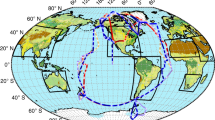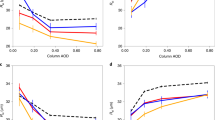Abstract
Particles lofted into the atmosphere by desert dust storms can disperse widely and affect climate directly through aerosol scattering and absorption. They can also affect it indirectly by changing the scattering properties of clouds and, because desert dusts are particularly active ice-forming agents, by affecting the formation and thermodynamic phase of clouds. Here I show that dust storms that occurred in Asia early in 2004 created unusual ice clouds over Alaska at temperatures far warmer than those expected for normal cirrus-cloud formation.
Similar content being viewed by others
Main
Although the direct light-scattering effects of dust storms are readily observed from satellites1, their indirect effects on clouds are difficult to quantify. Knowledge about the effects of desert dusts on clouds has come from polarization lidars (detection systems that work on radar principles but use laser light), which can identify both non-spherical aerosols and the phase of clouds2. The evidence suggests that, even after great transport distances, aerosols from both the Asian and Saharan deserts affect cirrus and supercooled water clouds3,4,5,6. It has long been known that desert dusts are highly effective as nuclei on which ice crystals form heterogeneously7.
From late February to mid May 2004, ruby (0.694 µm wavelength) polarization-lidar observations8 from the University of Alaska at Fairbanks (64.86 °N, 147.84 °W) regularly detected elevated dust layers, which were tracked back to a series of Asian dust storms. In many cases, the dust layers sporadically developed embedded ice-crystal clouds. This phenomenon is illustrated in Fig. 1 by the backscattered laser power and linear depolarization ratio (δ, which is the ratio of the powers in the planes of polarization orthogonal and parallel to that transmitted). Figure 1 shows two hours of lidar display over a range of heights. Aerosols are particularly apparent in stratified layers at between about 4.5 and 6.5 km of height because of their enhanced backscattering (an increase in display brightness) and depolarization (values of δ, 0.1–0.2) compared with that produced by molecular scattering. Also prominent is the embedded ice cloud centred at 5.5 km at about 20:30 GMT, which displays even stronger backscattering and depolarization. This cloud had a minimum temperature of −36 °C and a maximum relative humidity (with respect to ice) of 103% (according to the bracketing local radiosonde data).
Displays of backscattered laser power (top; logarithmic grey scale) and linear depolarization ratio (colour scale; δ is the ratio of the powers in the planes of polarization orthogonal and parallel to that transmitted) are given for a two-hour period on 29 February 2004, as debris from an Asian dust storm drifted over the interior of Alaska.
Similar mixed dust and ice layers were observed with cloud-top temperatures between about −15 °C and −40 °C: these are abnormally warm compared with those of cirrus clouds, which form by the homogeneous nucleation of haze particles8. The corresponding relative humidities indicate an almost ice-saturated environment, which also contrasts with the high supersaturations needed for cirrus formation9. In laboratory experiments, dust particles needed ice supersaturations of only 10–15% to nucleate ice crystals directly from the vapour10.
Although there have been previous indications that desert dusts alter clouds3,4,5,6, to my knowledge this is the first time that they have been shown to serve as deposition ice nuclei in the atmosphere and to create ice clouds at modest supersaturations and temperatures. Desert dust storms are a natural part of our world, but we must be wary in case human activities in arid lands, or climate change itself, are increasing aerosol amounts and so further altering climate by affecting distant clouds.
References
Kaufman, Y. K., Tunré, D. & Boucher, O. Nature 419, 215–223 (2002).
Sassen, K. in Lidar (ed. Weitkamp, C.) 19–42 (Springer, Berlin, 2005).
Murayama, T. N. et al. J. Geophys. Res. 106, 18345–18360 (2001).
Sassen, K. Geophys. Res. Lett. 29, 1465 doi:10.1029/2001GL014051 (2002).
Sassen, K., DeMott, P. J., Prospero, J. M. & Poellot, M. R. Geophys. Res. Lett. 30, 1633 doi:10.1029/2003GL017371 (2003).
Sakai, T., Nagai, T., Nakazto, M. & Matsumura, T. Geophys. Res. Lett. 31, L06128 doi:10.1029/2003GL019332 (2004).
Isono, K., Komabayasi, M. & Ono, A. J. Meteorol. Soc. Jpn 37, 211–233 (1959).
Sassen, K. & Campbell, J. R. J. Atmos. Sci. 58, 481–496 (2001).
Comstock, J. M., Ackerman, T. P. & Turner, D. D. Geophys. Res. Lett. 31, L11106 doi:10.1029/2004GL019705 (2004).
Bailey, M. & Hallett, J. Q. J. R. Meteorol. Soc. 128, 1461–1483 (2002).
Author information
Authors and Affiliations
Corresponding author
Ethics declarations
Competing interests
The author declares no competing financial interests.
Rights and permissions
About this article
Cite this article
Sassen, K. Dusty ice clouds over Alaska. Nature 434, 456 (2005). https://doi.org/10.1038/434456a
Published:
Issue Date:
DOI: https://doi.org/10.1038/434456a
This article is cited by
-
The implications of dust ice nuclei effect on cloud top temperature in a complex mesoscale convective system
Scientific Reports (2017)
-
The Clouds of the Middle Troposphere: Composition, Radiative Impact, and Global Distribution
Surveys in Geophysics (2012)
-
Laboratory study of heterogeneous ice nucleation in deposition mode of montmorillonite mineral dust particles aged with ammonia, sulfur dioxide, and ozone at polluted atmospheric concentrations
Air Quality, Atmosphere & Health (2008)
-
Increased Arctic cloud longwave emissivity associated with pollution from mid-latitudes
Nature (2006)
Comments
By submitting a comment you agree to abide by our Terms and Community Guidelines. If you find something abusive or that does not comply with our terms or guidelines please flag it as inappropriate.




